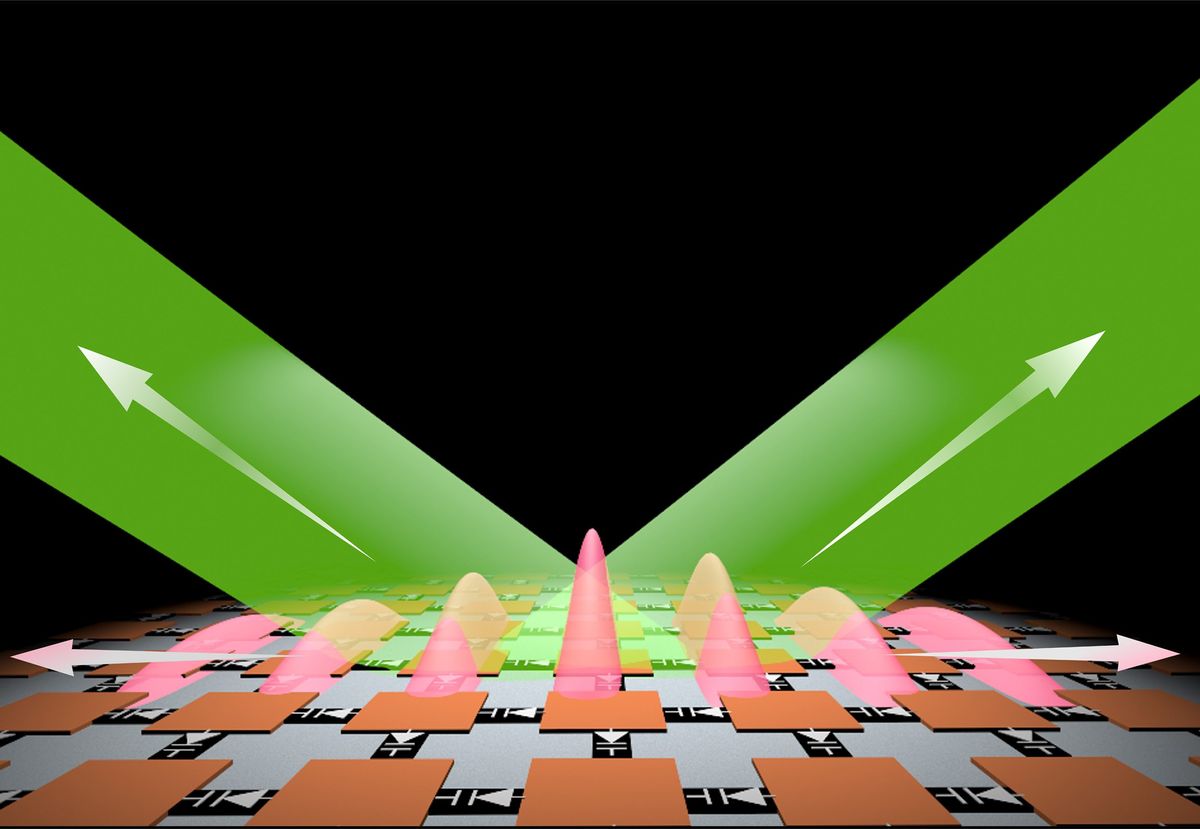A novel kind of time crystal can amplify light, potentially leading to significantly better lasers and next-generation wireless communications, a new study finds.
A normal crystal is a structure of many atoms organized into a regular pattern in space. However, in 2012, Nobel laureate Frank Wilczek conceived of time crystals, in which many particles are ordered into regular series of motions—patterns that repeat in time rather than space. Researchers successfully created the first time crystals in 2017.
Recently, scientists have also developed photonic time crystals, in which optical properties vary regularly over time. In theory, photonic time crystals may lead to new unusual ways to control light. For example, the fact that photons in such crystals are ordered in a pattern that is synchronized across time can lead to constructive interference, which could be used to amplify light.
Most of the research on photonic time crystals to date has been theoretical. In these studies, photonic time crystals were typically assumed to be bulk 3D structures “similar to usual crystals,” says study lead author Xuchen Wang, an electrical engineer at the Karlsruhe Institute of Technology in Germany. As a result, until now, all photonic time crystals were three dimensional.
However, creating 3D photonic time crystals has proven very difficult, and experiments with these structures have so far not moved past toy model systems with no practical applications. Lower frequencies, such as microwaves, need extraordinarily complex 3D networks of electronic circuits. For visible frequencies, the challenge is making sure the optical properties of every part of the structure changes uniformly over time.
Now researchers have simplified the problem by creating a photonic time crystal whose structure is two dimensional. “We only needed to create a surface instead of a bulk material,” Wang says.
In the new study, Wang and his colleagues experimented with artificial 2D structures known as metasurfaces. These metastructures and similar metamaterials are engineered to possess features not generally found in nature, such as the ability to bend light in unexpected ways. Research on metastructures has led to invisibility cloaks that can hide objects from light, heat, sound, and other types of waves, as well as metadevices that could enable ultraquick telecommunications at terahertz frequencies.
The scientists explored 2D photonic time crystals essentially for the same reason that metastructure researchers have often investigated metasurfaces.
“Metamaterials are 3D artificial materials which have many interesting properties, but they are often expensive, heavy, and suffer from losses, which limits their usefulness,” Wang says. “To address these issues, scientists created 2D versions of metamaterials, called metasurfaces, which have similar functions to 3D metamaterials but are smaller, lighter, cheaper, and have fewer losses. As a result, metasurfaces are nowadays widely used in microwave and optical engineering.”
Metastructures are made up of structures with repeating patterns at scales that are smaller than the wavelengths of light they are designed to manipulate. In the new study, the researchers experimented with metasurfaces designed to control microwaves.
“Our group possesses a wealth of expertise in designing artificial 2D materials,” Wang says. “Therefore, why not study and make a 2D photonic time crystal?”
The scientists found these new structures could amplify microwaves shining on them as theoretically predicted. “Our research has revealed that even 2D single-layer photonic time crystals can exhibit similar physical properties as their volumetric 3D counterparts, which is a highly surprising and exciting discovery,” Wang says.
In addition, 2D photonic time crystals do not only amplify electromagnetic waves that shine on them in free space, but also waves traveling along their surfaces. This effect “is not a property of 3-D photonic time crystals,” Wang notes.
These findings underscore the novel ways in which researchers are increasingly tinkering with time. For example, in one recent unrelated study, when light signals passed through a newly developed “time interface,” they experienced “temporal reflections,” behaving as if they were traveling backward in time. In another study, scientists had light waves interact with each other after crossing through gaps not in space, but time.
The new 2D photonic time crystals may have many applications, Wang and his colleagues say. For instance, they could simplify laser designs by removing the need for the bulky mirrors typically used to amplify light within lasers.
In addition, the fact that 2D photonic time crystals can amplify surface waves is potentially significant for next-generation wireless telecommunications. Recently, scientists have begun exploring “intelligent surfaces“ that make use of surface waves. However, these signals suffer from severe losses as they ripple across materials. A 2D photonic time crystal could help fight this signal decay by boosting the surface waves.
“Our 2D photonic time crystals could be integrated into future 6G reconfigurable intelligent surfaces and enhance communication efficiency,” Wang says.
Future research can seek to develop 2D photonic time crystals for other wavelengths, such as visible ones, the researchers say. The new study may also help pave the way for photonic space-time crystals whose optical properties vary regularly across both space and time.
“We believe that there are many more unique and interesting properties to discover in 2D photonic time crystals, and we are excited to explore them with further research,” Wang notes.
The scientists detailed their findings online 5 April in the journal Science Advances.
- 6G Is Years Away, but the Power Struggles Have Already Begun ... ›
- This Mirror Reverses How Light Travels in Time ›
- What’s a Time Crystal? ›
- Photons Crash Into Each Other—on a Time Mirror - IEEE Spectrum ›
Charles Q. Choi is a science reporter who contributes regularly to IEEE Spectrum. He has written for Scientific American, The New York Times, Wired, and Science, among others.



